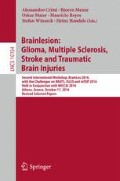Abstract
Deep learning techniques have been widely adopted for learning task-adaptive features in image segmentation applications, such as brain tumor segmentation. However, most of existing brain tumor segmentation methods based on deep learning are not able to ensure appearance and spatial consistency of segmentation results. In this study we propose a novel brain tumor segmentation method by integrating a Fully Convolutional Neural Network (FCNN) and Conditional Random Fields (CRF), rather than adopting CRF as a post-processing step of the FCNN. We trained our network in three stages based on image patches and slices respectively. We evaluated our method on BRATS 2013 dataset, obtaining the second position on its Challenge dataset and first position on its Leaderboard dataset. Compared with other top ranking methods, our method could achieve competitive performance with only three imaging modalities (Flair, T1c, T2), rather than four (Flair, T1, T1c, T2), which could reduce the cost of data acquisition and storage. Besides, our method could segment brain images slice-by-slice, much faster than the methods patch-by-patch. We also took part in BRATS 2016 and got satisfactory results. As the testing cases in BRATS 2016 are more challenging, we added a manual intervention post-processing system during our participation.
Access this chapter
Tax calculation will be finalised at checkout
Purchases are for personal use only
References
Menze, B.H., Jakab, A., Bauer, S., Kalpathy-Cramer, J., Farahani, K., Kirby, J., Burren, Y., Porz, N., Slotboom, J., Wiest, R., et al.: The multimodal brain tumor image segmentation benchmark (BRATS). IEEE Trans. Med. Imaging 34, 1993–2024 (2015)
Bauer, S., Wiest, R., Nolte, L.-P., Reyes, M.: A survey of MRI-based medical image analysis for brain tumor studies. Phys. Med. Biol. 58, 97–129 (2013)
Goetz, M., Weber, C., Binczyk, F., Polanska, J., Tarnawski, R., Bobek-Billewicz, B., Koethe, U., Kleesiek, J., Stieltjes, B., Maier-Hein, K.H.: DALSA: domain adaptation for supervised learning from sparsely annotated MR images. IEEE Trans. Med. Imaging 35, 184–196 (2016)
Prastawa, M., Bullitt, E., Ho, S., Gerig, G.: A brain tumor segmentation framework based on outlier detection. Med. Image Anal. 8, 275–283 (2004)
Cobzas, D., Birkbeck, N., Schmidt, M., Jagersand, M., Murtha, A.: 3D variational brain tumor segmentation using a high dimensional feature set. In: IEEE 11th International Conference on Computer Vision, pp. 1–8 (2007)
Goetz, M., Weber, C., Bloecher, J., Stieltjes, B., Meinzer, H.-P., Maier-Hein, K.: Extremely randomized trees based brain tumor segmentation. In: Proceedings MICCAI BraTS (Brain Tumor Segmentation Challenge), pp. 6–11 (2014)
Kleesiek, J., Biller, A., Urban, G., Kothe, U., Bendszus, M., Hamprecht, F.: Ilastik for multi-modal brain tumor segmentation. In: Proceedings MICCAI BraTS (Brain Tumor Segmentation Challenge), pp. 12–17 (2014)
Davy, A., Havaei, M., Warde-farley, D., Biard, A., Tran, L., Jodoin, P.-M., Courville, A., Larochelle, H., Pal, C., Bengio, Y.: Brain tumor segmentation with deep neural networks. In: Proceedings MICCAI BraTS (Brain Tumor Segmentation Challenge), pp. 1–5 (2014)
Urban, G., Bendszus, M., Hamprecht, F., Kleesiek, J.: Multi-modal brain tumor segmentatioin using deep convolutional neural networks. In: Proceedings MICCAI BraTS (Brain Tumor Segmentation Challenge), pp. 31–35 (2014)
Zikic, D., Ioannou, Y., Brown, M., Criminisi, A.: Segmentation of brain tumor tissues with convolutional neural networks. In: Proceedings MICCAI BraTS (Brain Tumor Segmentation Challenge), pp. 36–39 (2014)
Dvorak, P., Menze, B.H.: Structured prediction with convolutional neural networks for multimodal brain tumor segmentation. In: Proceedings MICCAI BraTS (Brain Tumor Segmentation Challenge), pp. 13–24 (2015)
Havaei, M., Davy, A., Warde-Farley, D., Biard, A., Courville, A., Bengio, Y., Pal, C., Jodoin, P.-M., Larochelle, H.: Brain tumor segmentation with deep neural networks. Med. Image Anal. 35, 18–31 (2017)
Vaidhya, K., Thirunavukkarasu, S., Alex, V., Krishnamurthi, G.: Multi-modal brain tumor segmentation using stacked denoising autoencoders. In: Proceedings MICCAI BraTS (Brain Tumor Segmentation Challenge), pp. 60–64 (2015)
Pereira, S., Pinto, A., Alves, V., Silva, C.A.: Brain tumor segmentation using convolutional neural networks in MRI images. IEEE Trans. Med. Imaging 35, 1240–1251 (2016)
Zheng, S., Jayasumana, S., Romera-Paredes, B., Vineet, V., Su, Z., Du, D., Huang, C., Torr, P.H.: Conditional random fields as recurrent neural networks. In: Proceedings of the IEEE International Conference on Computer Vision, pp. 1529–1537 (2015)
Tustison, N.J., Avants, B.B., Cook, P.A., Zheng, Y., Egan, A., Yushkevich, P.A., Gee, J.C.: N4ITK: improved N3 bias correction. IEEE Trans. Med. Imaging 29, 1310–1320 (2010)
Krähenbühl, P., Koltun, V.: Efficient inference in fully connected CRFs with Gaussian edge potentials. NIPS (2011)
Jia, Y., Shelhamer, E., Donahue, J., Karayev, S., Long, J., Girshick, R., Guadarrama, S., Darrell, T.: Caffe: convolutional architecture for fast feature embedding. In: Proceedings of the 22nd ACM International Conference on Multimedia, pp. 675–678 (2014)
Acknowledgements
This work was supported by the National High Technology Research and Development Program of China (2015AA020504) and the National Natural Science Foundation of China under Grant No. 61572499, 61421004.
Author information
Authors and Affiliations
Corresponding authors
Editor information
Editors and Affiliations
Rights and permissions
Copyright information
© 2016 Springer International Publishing AG
About this paper
Cite this paper
Zhao, X., Wu, Y., Song, G., Li, Z., Fan, Y., Zhang, Y. (2016). Brain Tumor Segmentation Using a Fully Convolutional Neural Network with Conditional Random Fields. In: Crimi, A., Menze, B., Maier, O., Reyes, M., Winzeck, S., Handels, H. (eds) Brainlesion: Glioma, Multiple Sclerosis, Stroke and Traumatic Brain Injuries. BrainLes 2016. Lecture Notes in Computer Science(), vol 10154. Springer, Cham. https://doi.org/10.1007/978-3-319-55524-9_8
Download citation
DOI: https://doi.org/10.1007/978-3-319-55524-9_8
Published:
Publisher Name: Springer, Cham
Print ISBN: 978-3-319-55523-2
Online ISBN: 978-3-319-55524-9
eBook Packages: Computer ScienceComputer Science (R0)

